After almost two months in the marina at Miri, it was time to move on. We made some good friends there and it’s highly likely we’ll meet up with several of them again. Like us, most of the people we’ve met are long-term travellers so our paths will hopefully cross at some future anchorage or marina. We had heard conflicting views about Labuan from our Miri neighbours. We could expect the marina to be a bit run down said some, while according to others the town doesn’t have much to offer. One couple had nothing but praise for its good cycling routes, nice fish restaurants and great shopping (they did admit the marina was a bit run down though). I was just eager to get back on the water, with the prospect of new surroundings to look forward to, even if they were likely to be less than salubrious. I felt that we had ‘done’ Miri. Time for a change.
The day before leaving, we checked out of Malaysia via the usual sequence of immigration, customs and harbour master (not ever necessarily or consistently in that order) which thankfully went smoothly and promptly. With just a few more fresh provisions to get and some stowing to do, we were all set for an early departure on the first day of December. I was a bit nervous that everyone would be on the pontoon to wave us off; a situation always guaranteed to make me get flustered and make mistakes. As it turned out, just Ian and Marilyn from the catamaran next door were there to let our lines go because we had said our goodbyes to people the previous evening. We motored out into the bay at 9am with no hassle and were soon experiencing the familiar side-to-side rocking from the swell as we progressed further out.
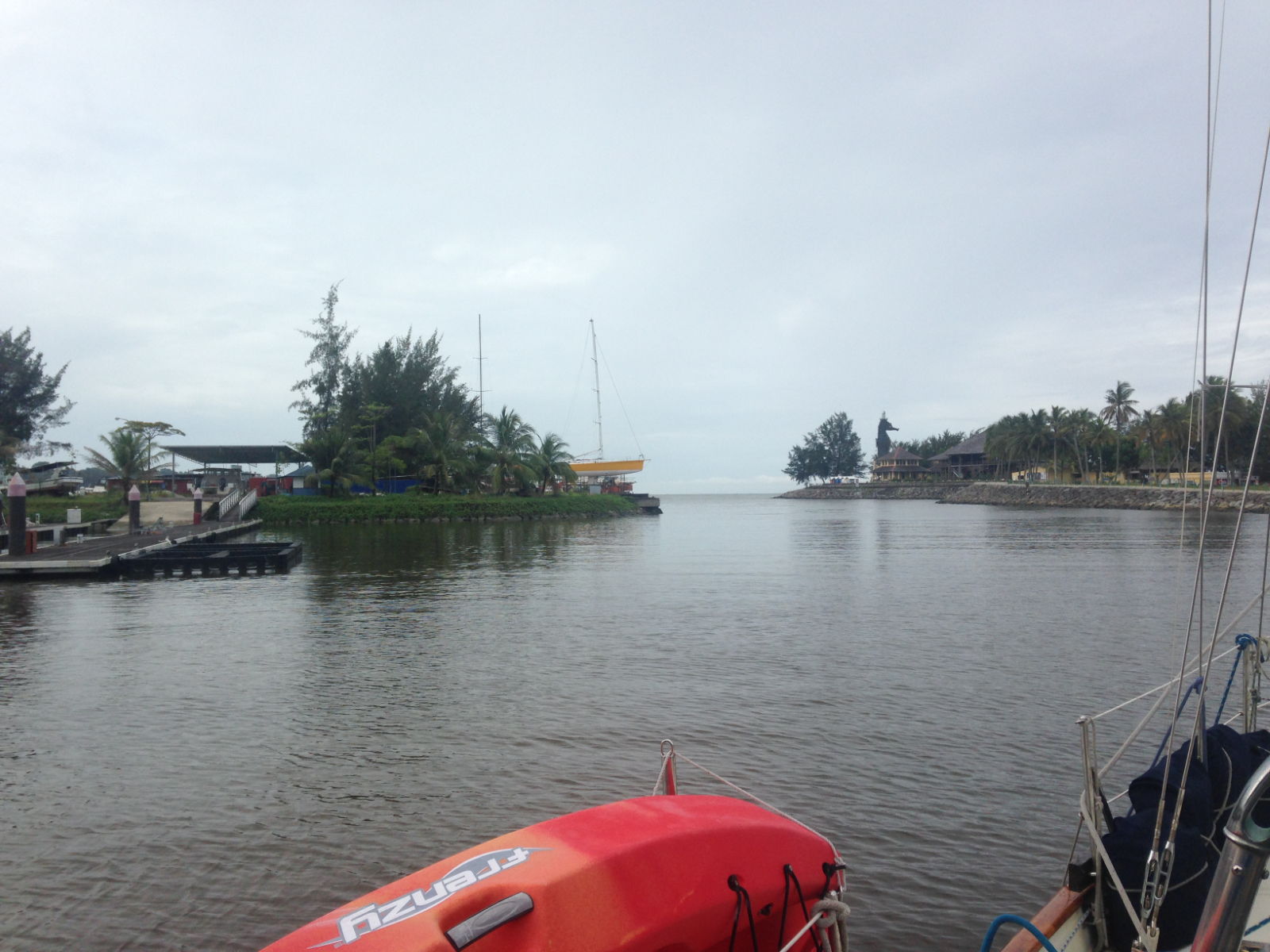
My sea legs always tend to desert me after a long period on land and I began to feel slightly nauseous when I went below. It was humid in the cockpit, however so I just sat still up there and zoned in to my latest book-related delight (Audible) while the autohelm took on steering duties. There were oil rigs and a few industrial boats, but not a lot else to look out for as Miri faded into the distance and the coast of Brunei grew closer. As we neared the river entrance the swell lessened and I began to feel better. The water was murky brown, and even though the depth was as low as 3 metres at times, it wasn’t possible to see the bottom. We ended up anchoring in 2.5 metres off the coast of Brunei in a place called Belait. Maybe because the word Brunei always makes me think ‘money’, I had the impression that the buildings lining the shore looked opulent, such as you’d see on wealthy parts of coastal Europe. It was a very peaceful spot until the speedboats arrived! These were what Paul described as rich boys’ toys. For most of the late afternoon they raced past and around us at lightning speeds, probably using our boat as a marker, and the noise was like being at a Grand Prix. I knew they wouldn’t be continuing in the dark, though so it wasn’t as irritating as it could have been.
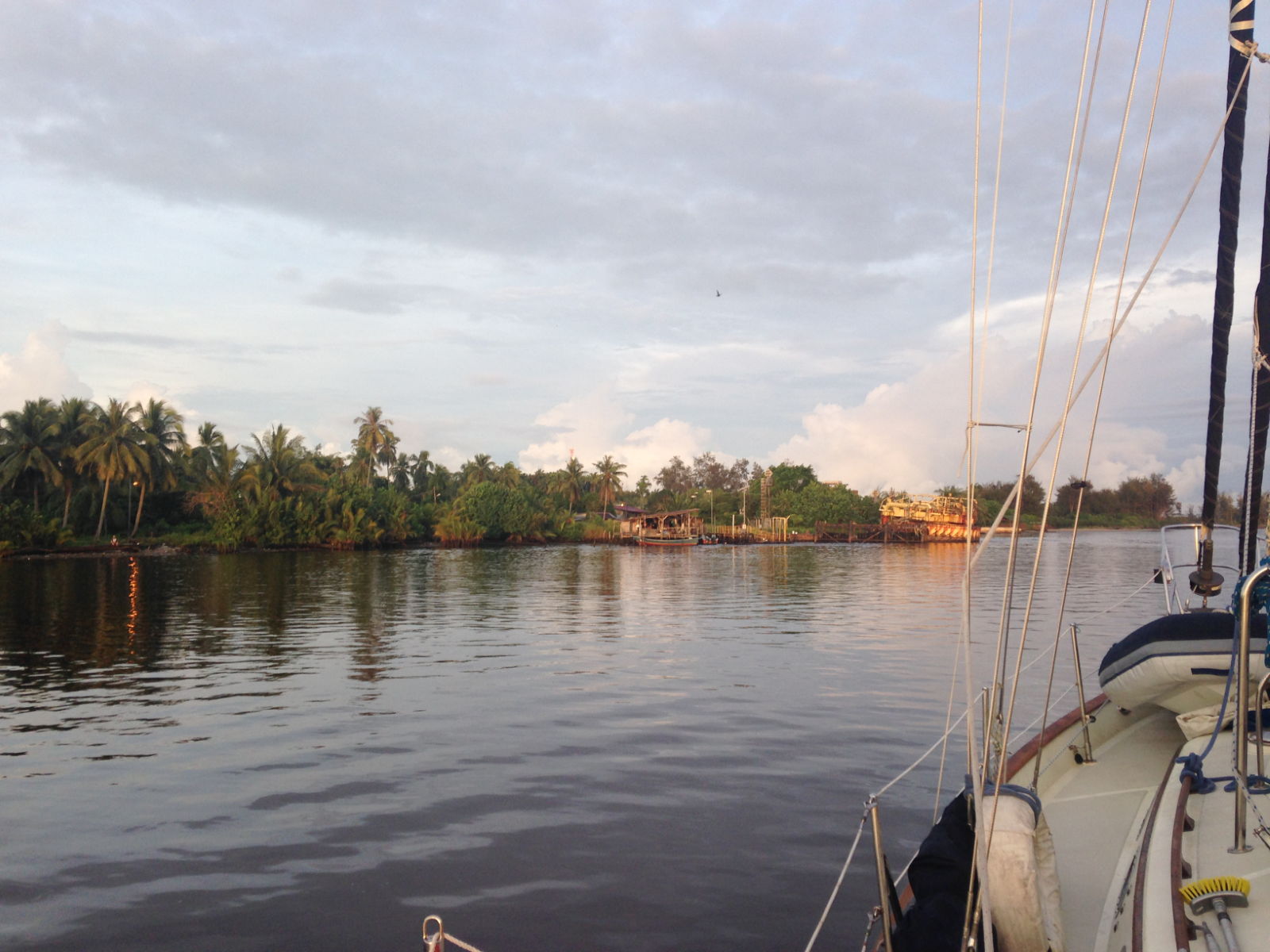
Jerudong was to be our next stop. We planned the route after dinner and discovered it would be an 8 or 9 hour passage. The chart had alarming warnings at various points on the route, such as ‘firing practice area’, ‘reefs’, ‘submerged rocks and pipelines’ but Paul just skirted around them with the cursor and said all would be fine. Anyway we would need to start early so we were on our way before 7am. It was a gorgeous morning, with a lovely cool breeze, and the sun had not long risen as we left the river in 5 metres of calm water.
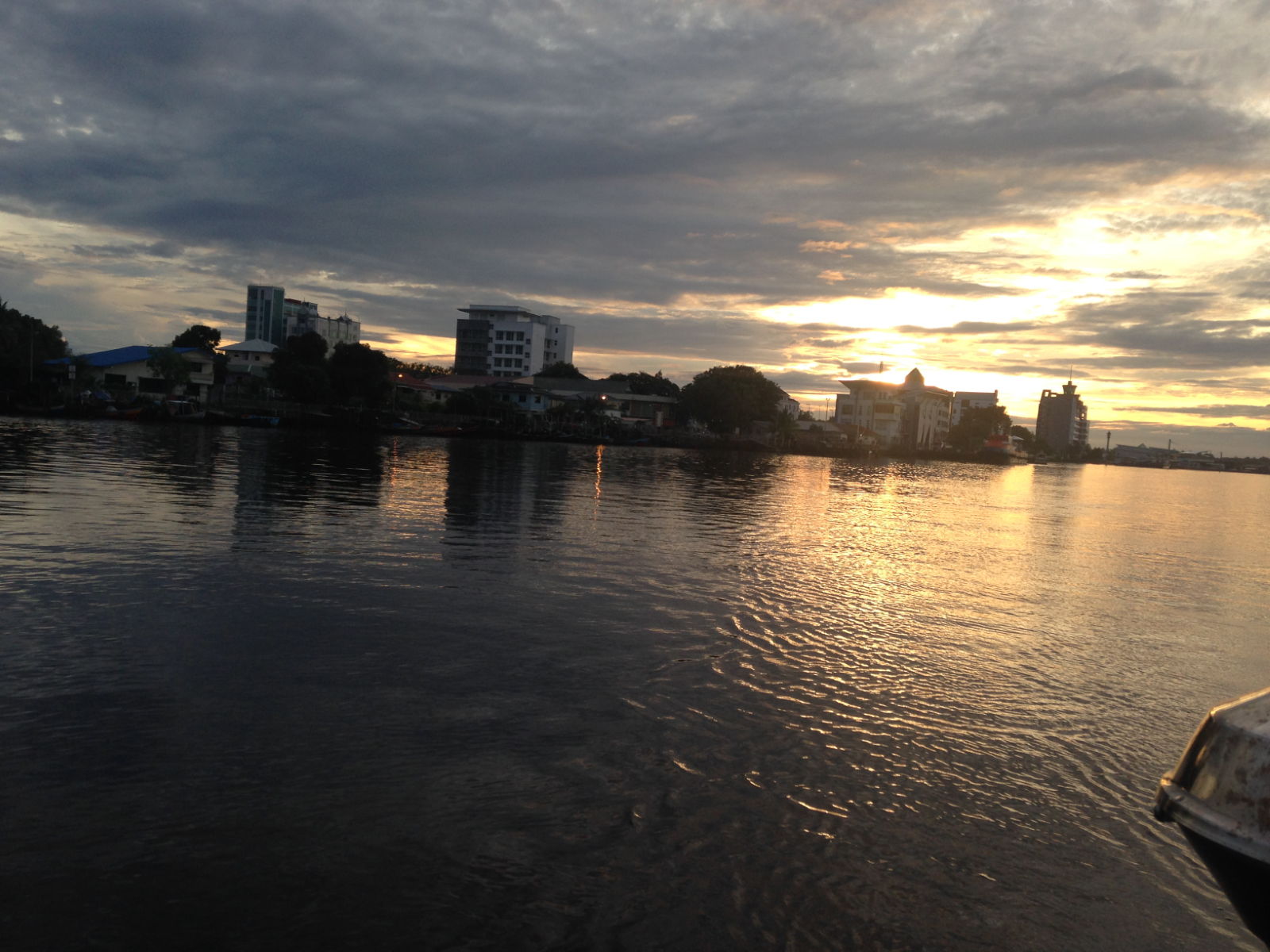
Further out, it looked a bit choppy so I made coffee before it became too rocky. With mugs of hot coffee, and bananas for breakfast we sat in the cockpit enjoying the breeze. Paul put the main sail up at 8, quickly followed by the headsail, and then a fishing line was put out at the stern. Unfortunately, a ‘huge’ fish grabbed it and he had to watch it all unravel and disappear into the water, complete with the lure. The mission to catch a fish goes on 😉


Jerudong was a strange place. The place we anchored was once destined to be a luxury marina until one of the Brunei princes spent all the country’s money. Work had stopped abruptly and it had an abandoned feel to it – eerie almost. We were the only boat there but would have had to leave if any of the royal family were using the nearby beach. It was gone 3 by then so there was little chance of them turning up. We did have mosquitoes for company later on, though and we both had bites in the morning.

Another early star for the next leg to Keraman. Paul had to fix the deckwash before we left so that he could blast all the mud off the chain with it. It was a shame the wind only allowed us to have the sails up for an hour or so without the engine on. Not only is it more peaceful and economical like that, it also means we don’t get the smell of diesel wafting into the cockpit. By 12 30 we were anchored fairly near to Labuan and were back in Malaysian territory. Due to the sea state we had to move twice before we finally settled. The first time was due to excessive rolling and the second time because Paul discovered the falling tide would cause us to go aground eventually. After that it was ‘as you were’; relaxing in the cockpit, watching the sunset; glass of wine; a good book; ‘words with friends’ games…lovely 🙂
We were in no great rush to leave in the morning as Labuan is only an hour away from Keraman. However, our sleep patterns seem to have reverted to an ‘early to bed, early to rise’ pattern and we were both up early anyway. This pattern is more suited to the tropical climate and lifestyle, and it’s wonderful to sit in the cockpit in the early morning sun. The approach to the marina at Labuan was very busy with container ships, fishing vessels and passenger ferries vying for position. Once we located the entrance we motored slowly in just before midday.
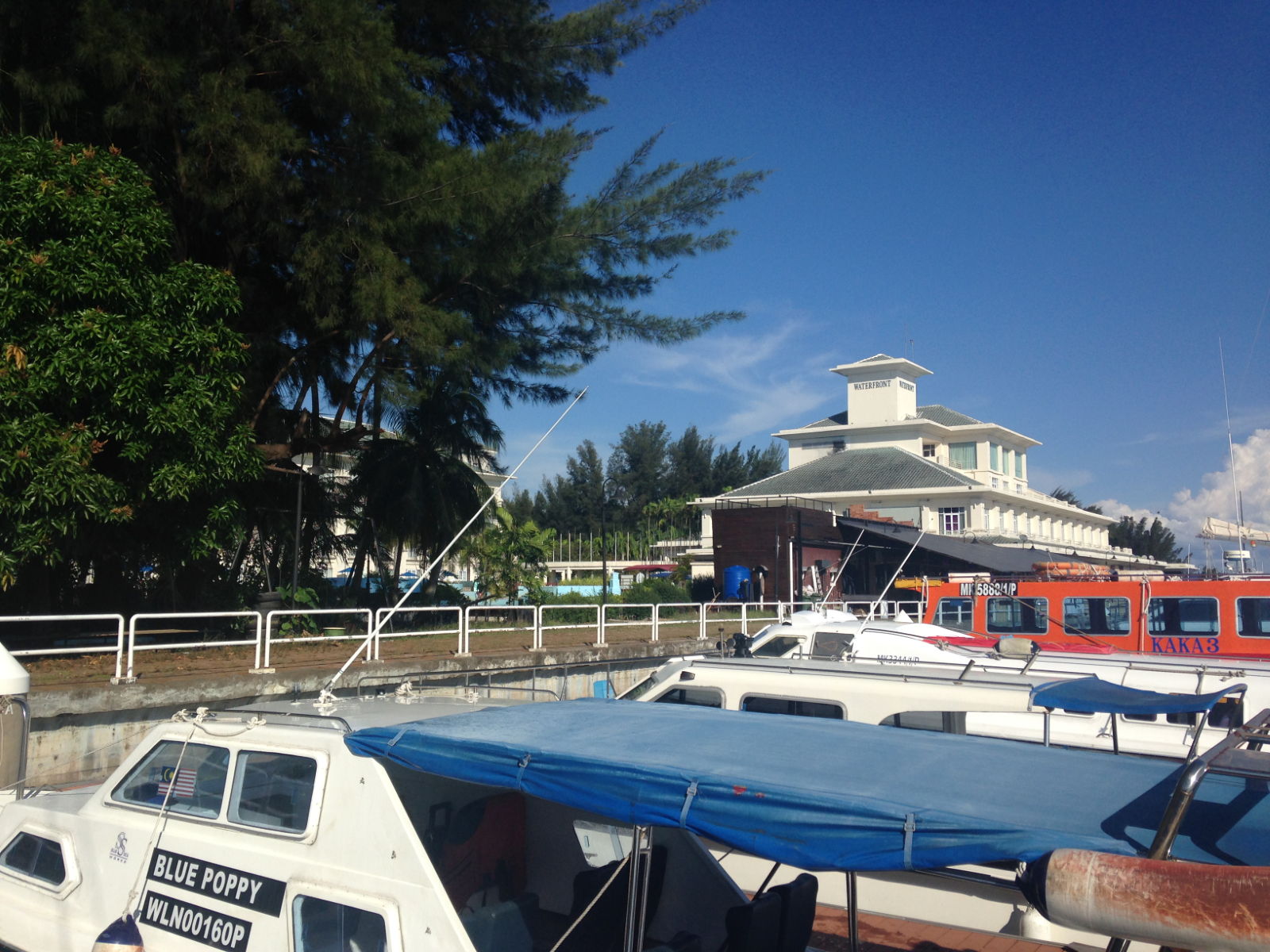
The sun was scorching hot; I could feel my skin burning despite the liberal amount of protection oil on it. The heat was the thing that caused me most stress on our first afternoon there. I simply could not get cool even with the canopy up and all the fans on. Paul told me the temperature was in the 40s! I resorted to frequent cold showers but the effect wore off fairly quickly and I was counting the hours until sundown. We had given away our air conditioning system to John and Carol in Miri because I found it too cold and restrictive. I didn’t like the fact that all the hatches and windows need to be closed when it’s on. Just this once, though I found myself longing for it! The marina itself is ‘ok’, the descriptions of its being a bit run down are accurate but it’s adequate for our needs. We have water and electricity…and duty free shops to explore.

Paul had a chat with Geoff not long after we got there, a friend he’d got to know via email and had finally met in Miri, so he gave us some useful local information. At 4 o’clock Paul suggested we walk over to the shopping mall to take advantage of its air conditioning. The walk there revealed more of just how run down the marina is. Some of the fingers had broken away from the pontoons and the water is crammed with floating rubbish of all kinds – obviously the ubiquitous plastic bottles and carrier bags, but also several sandals, paint tins and other domestic waste, as Paul showed in his pictures. We passed a nice-looking bar which is part of the luxury hotel next to the marina. Beyond the marina entrance was a park, a busy main road and the huge mall, lined with duty free outlets offering cheap alcohol, chocolate, perfumes etc. We had a quick look but were in no hurry to get anything, just to get cool was enough for me. The mall wasn’t as icy cool as we expected, however because the air conditioning had broken, but it was more bearable than the inside of the boat. We found the supermarket in the usual location of the basement and picked up a few essentials, then had a walk around to check out the cafes and restaurants but none of them appealed to us. We decided to have a walk into town later. At 7pm it was still hot and humid. The walk took about 30 minutes and it was dark by then so it was hard to get a proper impression of the town but the centre seemed lively with plenty of shops and restaurants. Paul had done some research and found us an Indian restaurant where we enjoyed a delicious curry and (for me) a glass of cold beer.
The following morning it was time to check in to Labuan. Even though it’s part of Malaysia, Sabah is an independent state, so immigration and customs need to be visited. As we’d be staying a week or so, we unpacked the bikes which had been folded and stowed in bags in the quarter berth for the passage to Labuan. It was good to know they can be put away and retrieved with very little hassle. We left early to avoid the heat, knowing that it’s never possible to tell how long the process will take. The morning temperature at 8am was bearable but held the promise of intensifying as the day went on. We passed the big hotel that it was too dark to see properly the previous evening, and cycled down the wide, tree-lined boulevard. It felt great to be back on the bikes. Once again, we were greeted and waved at by several of the people we passed. We didn’t see many other cyclists so maybe bike riding is a bit of a novelty here. Checking in done, we explored the town further and came upon a huge fruit and veg market near the waterfront.
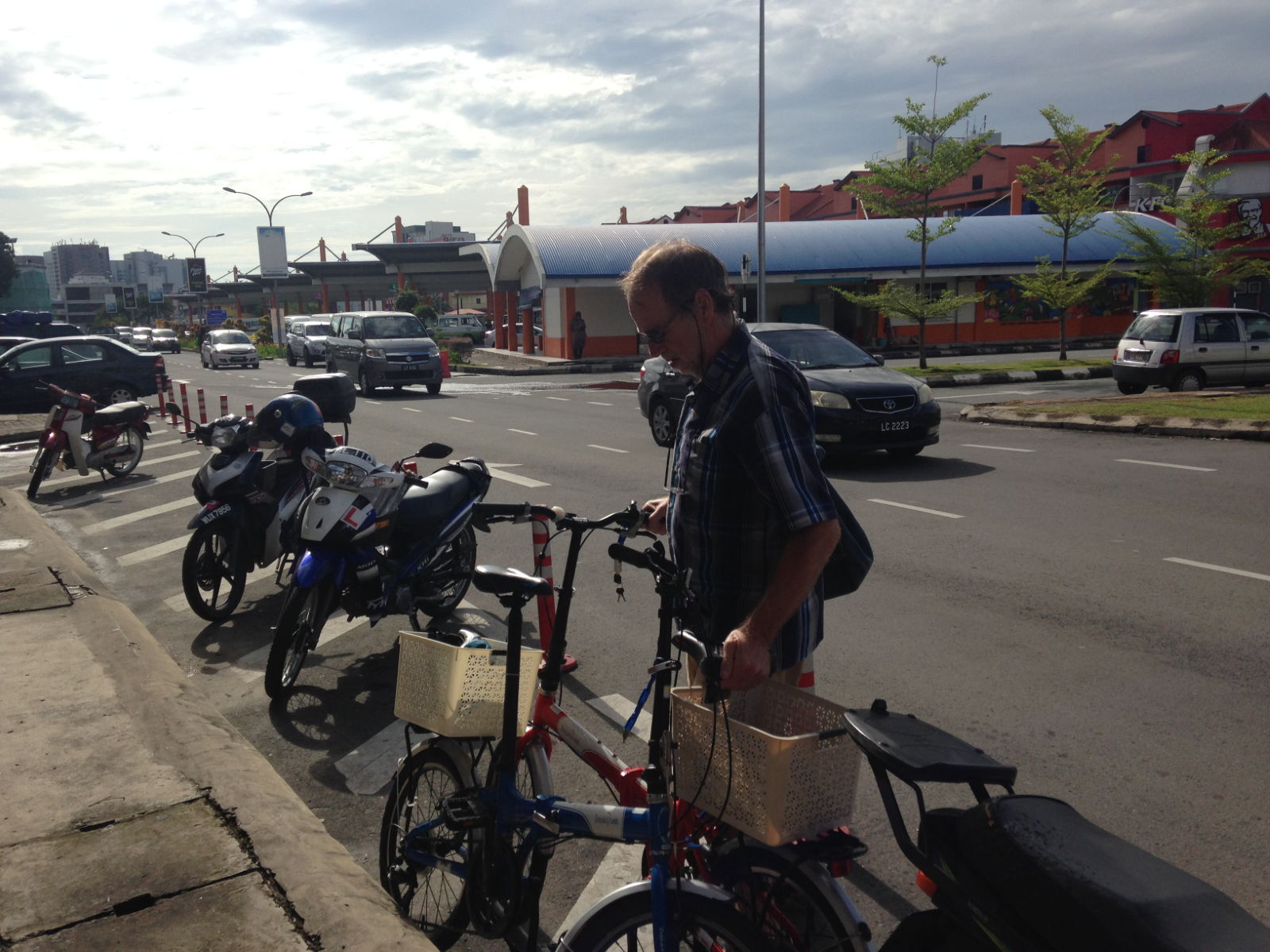
We spent a pleasant hour there selecting fresh produce and looking at the wide range of stuff for sale. The picture shows how massive the place is, and there was more on the floor above, although this was just typical market fare: plastic containers galore, materials, cheap clothes, make up and household goods. Paul found a shop devoted to fishing gear and spent some time inside, debating which products would help get him a fish 😉 On the way back we bought some wine. From the £10 – £12 it cost in Miri, it was a welcome sight to see it with price tags of £5 for the cheapest. Only red wine is available in boxes though, so it would take a few trips to stock up and stash the bottles in our bike baskets.
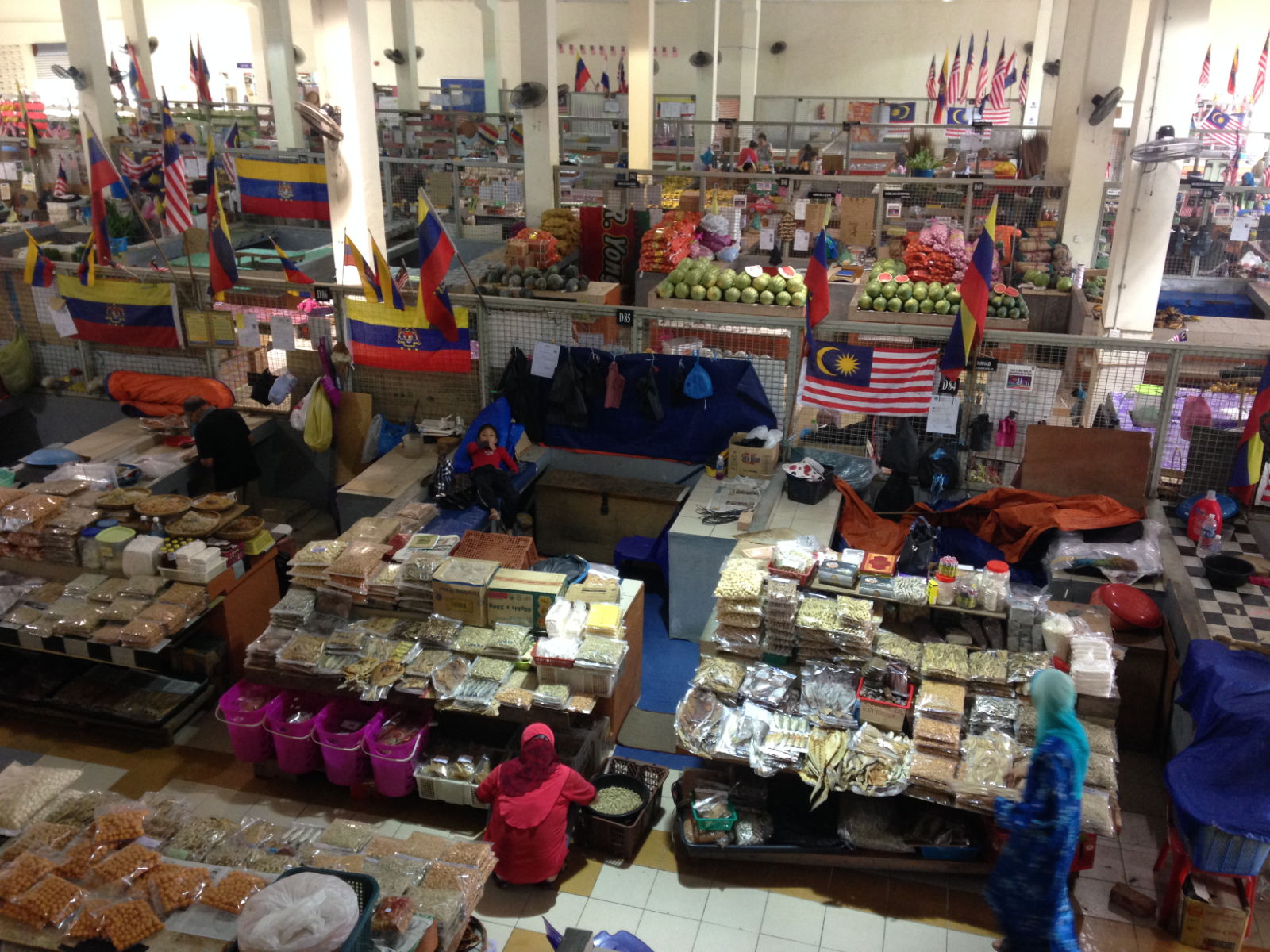
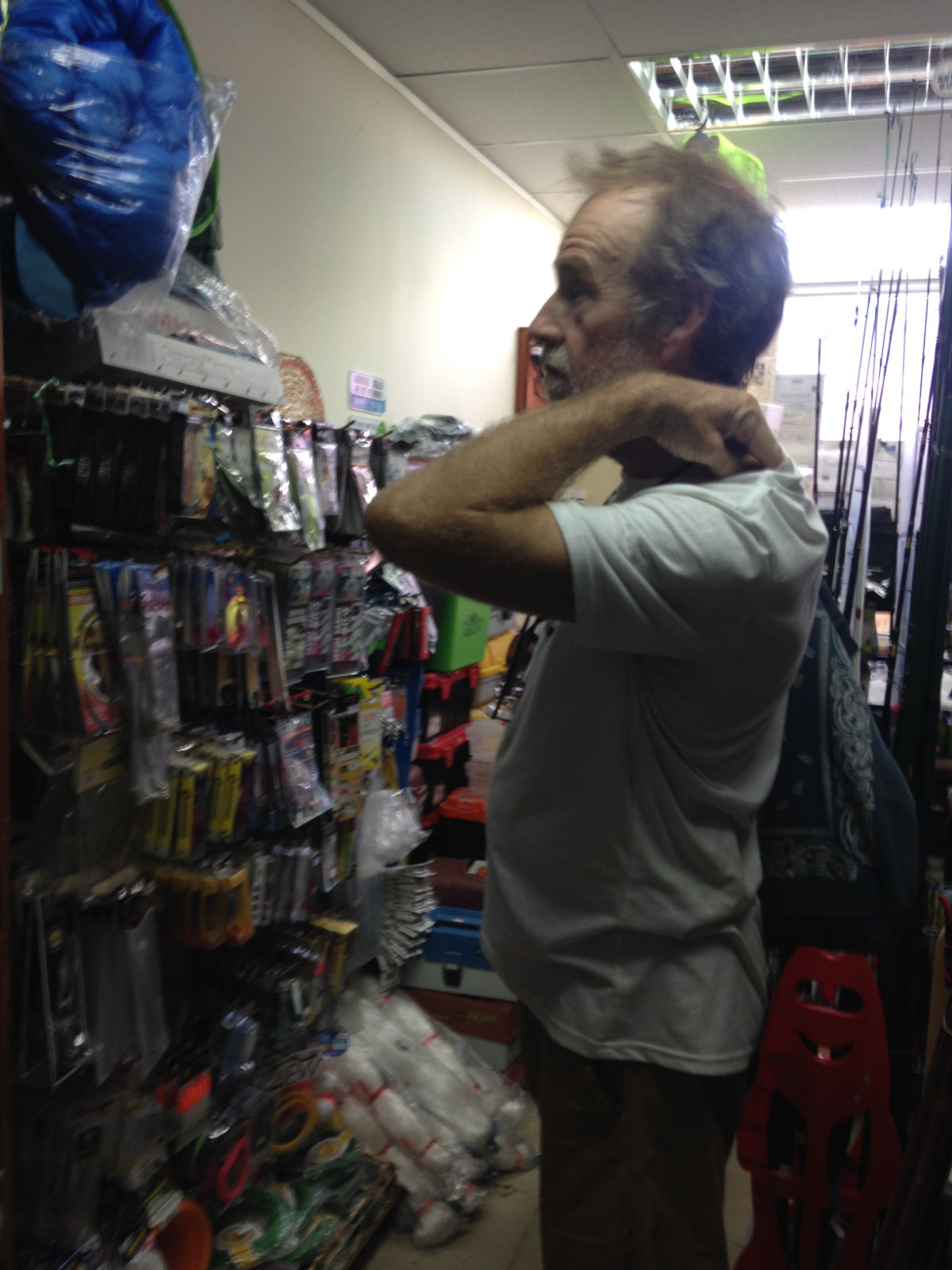
Later in the evening we cycled to Ramsey Point, a beach and promenade area further along the coast. Here, in 1846, the Sultan of Brunei handed over control of Labuan to the British. Almost a hundred years later, on 10 June 1945 the beach was used to land Allied forces liberating Labuan from the Japanese occupation. We had a walk around and had a look at the restaurant at the end of the pier where you cook your own food at the table after selecting ingredients from a buffet. People were having great fun on the zip wire attraction that had been set up from the balcony of a high tower, down to the edge of the pier. Shame that it closed before we had a chance to have a go.
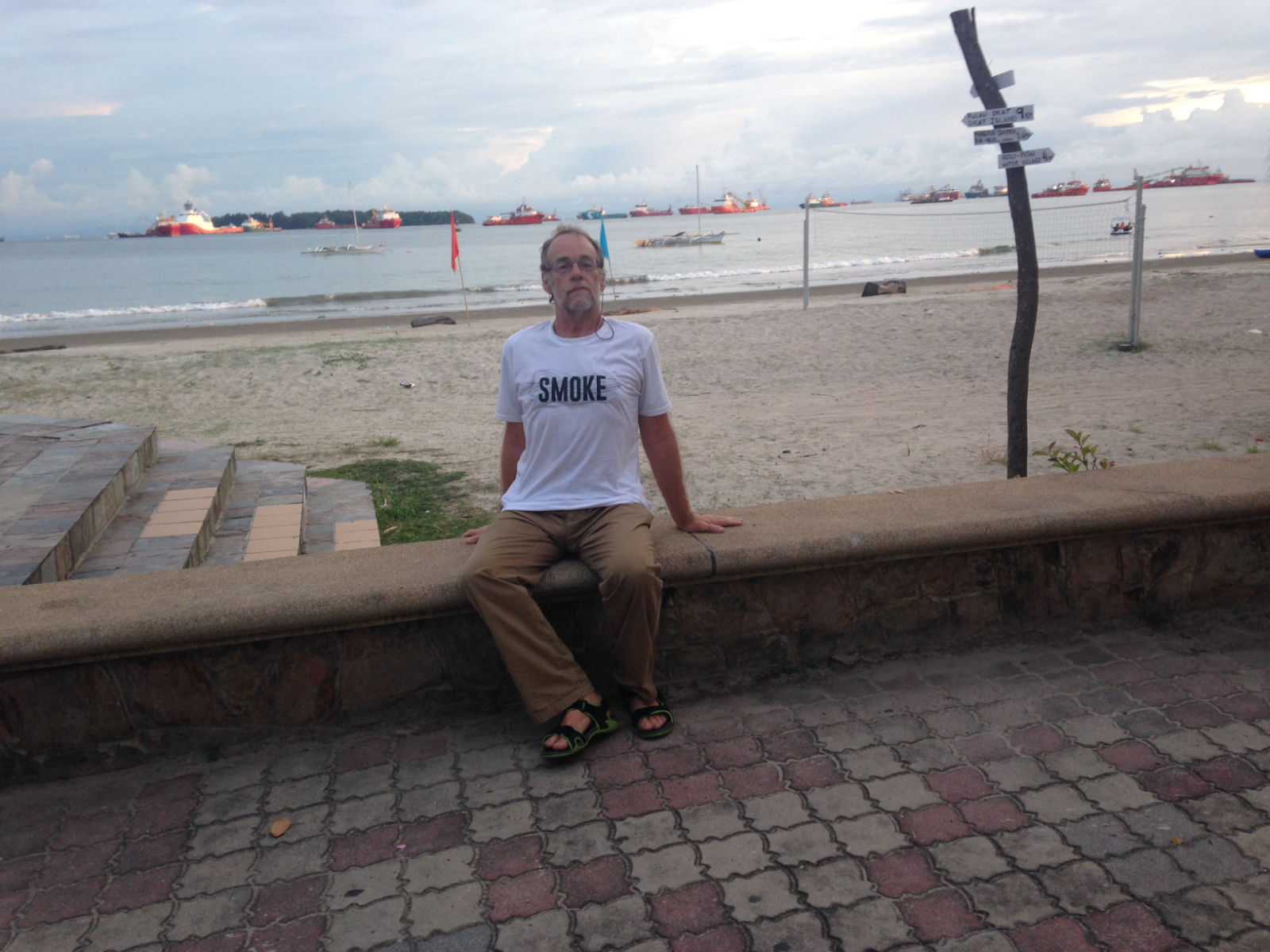

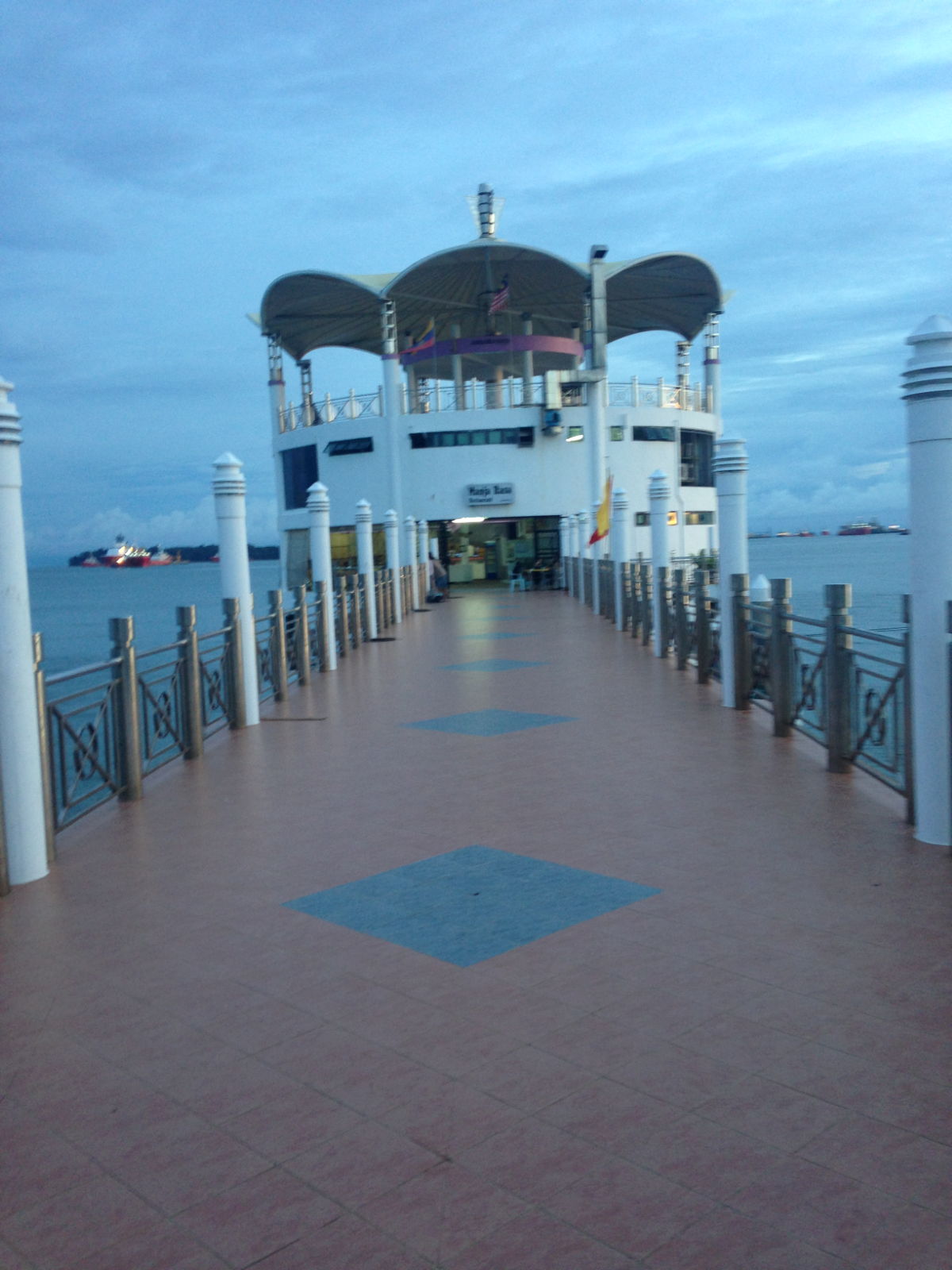
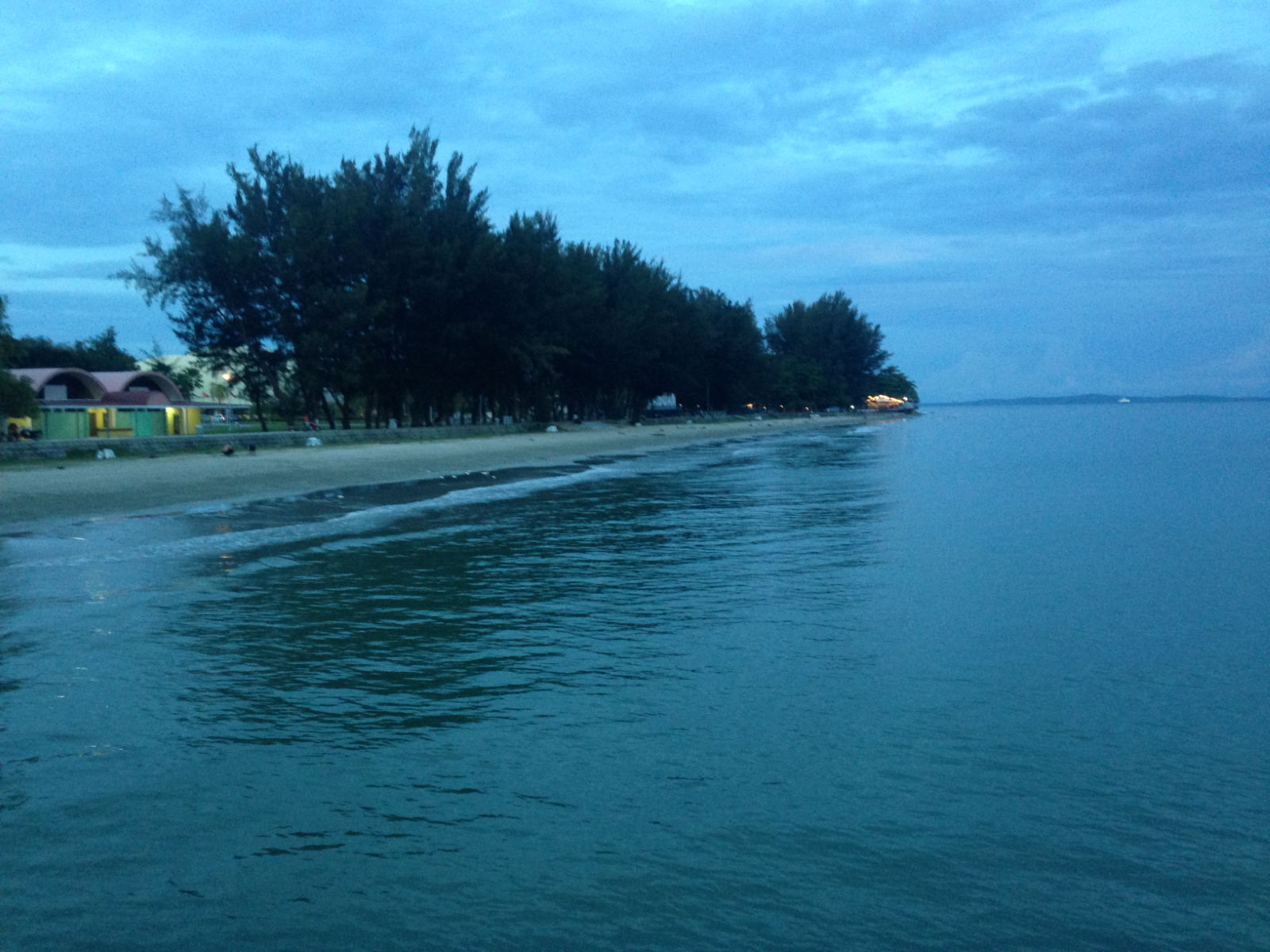
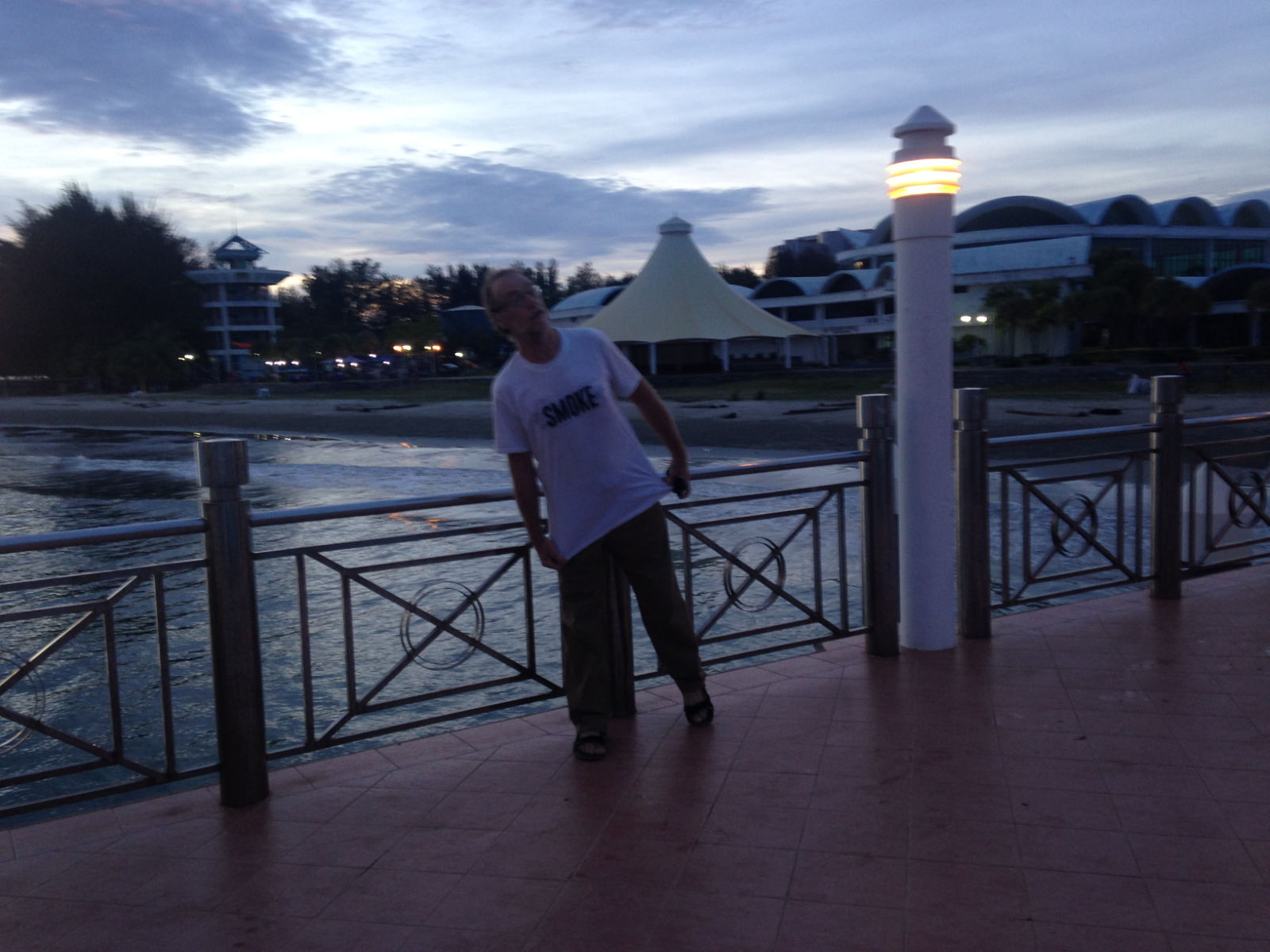
Before returning to the boat we stopped at the hotel bar opposite the marina. We had to go through the reception of the plush hotel to get to it and were kindly escorted by one of their smartly-clad staff. Only red wine was available by the glass so I opted for a beer. The lady who took the order urged me to take advantage of the two for one offer that was in operation for that hour. I said I couldn’t manage two but Paul pointed out that we could take the second can back with us. The pint glass, when it arrived looked more than I could manage so there was no way I would be taking advantage of another one for free. This was another of the bars that could have been anywhere in Europe and I knew that one visit would be enough for us.
Early in the morning we went aground! Or rather, the keel was bouncing on the bottom due to a very low tide at 7am. I knew something was amiss because it felt like were being jerked, as if someone was pulling on our mooring ropes, a most unnerving feeling. It didn’t last long though before the tide began to rise again. In the afternoon we visited Labuan’s botanical gardens. The cycle ride there was lovely, probably one which had led keen cyclists, John and Carol to praise the place. There were one or two steep hills, unlike Miri but it was good exercise and going down them was exhilarating. Pics below of the gardens, which were lush and pretty and provided much needed shade from the sun. I wish there had been a bit more information about the location of the official residence of Labuan’s British Governors. It had been built in 1852 but was destroyed in 1945 during WW2. There were photographs of it but it was hard to determine where it had stood exactly. Apparently, only a tiny fragment of it remains and the grounds were landscaped and converted into a public park in 2001.
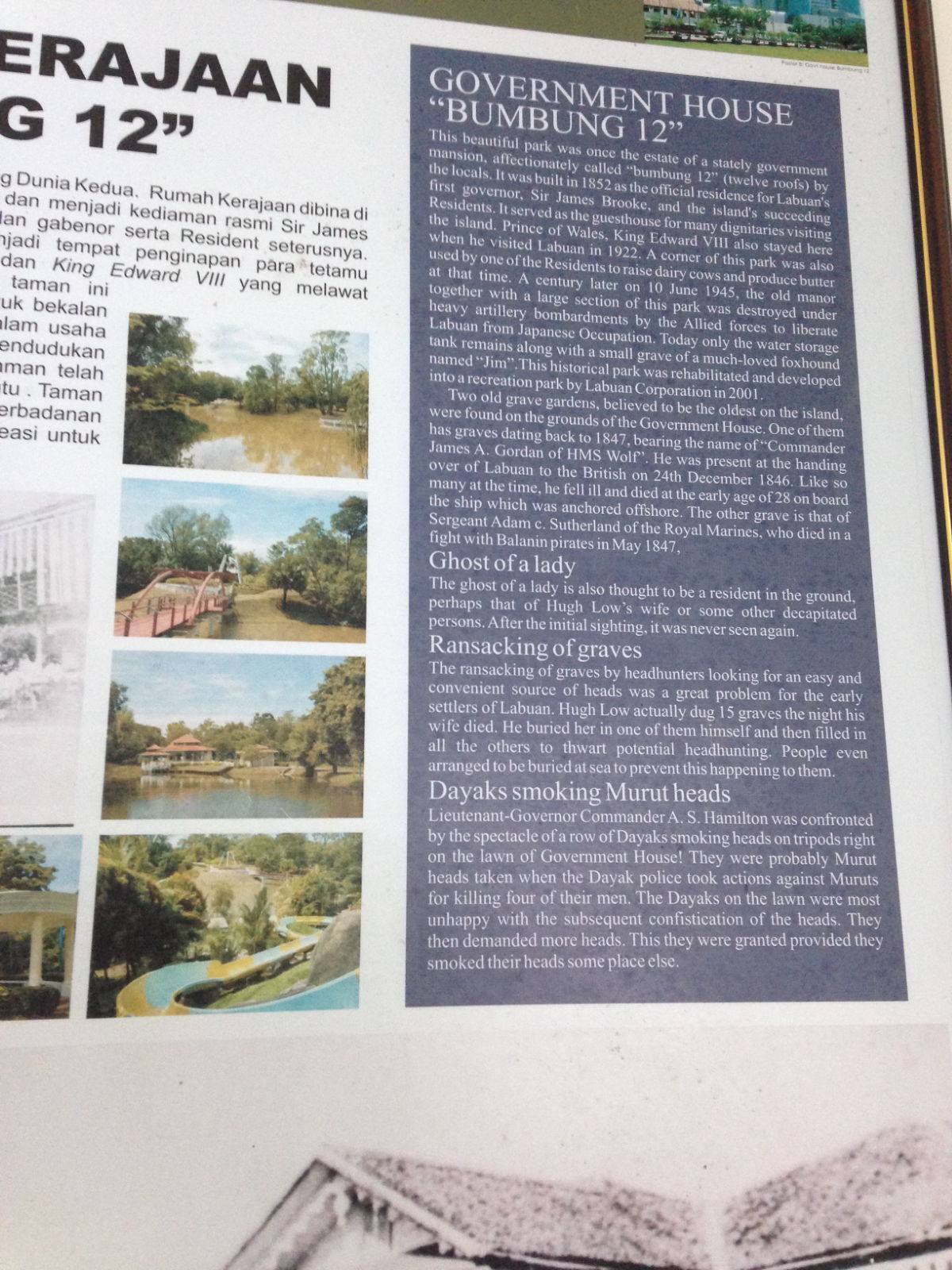
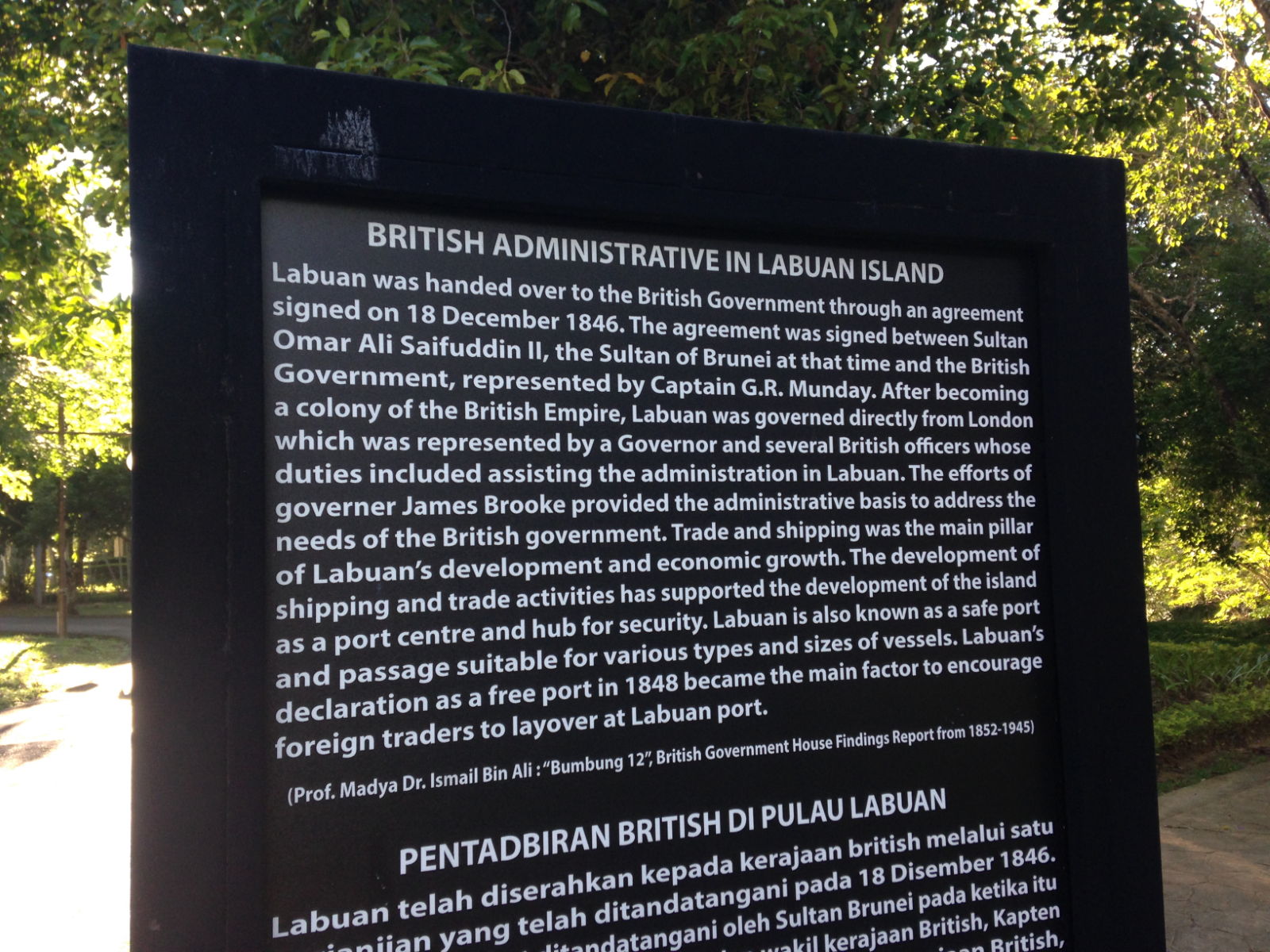
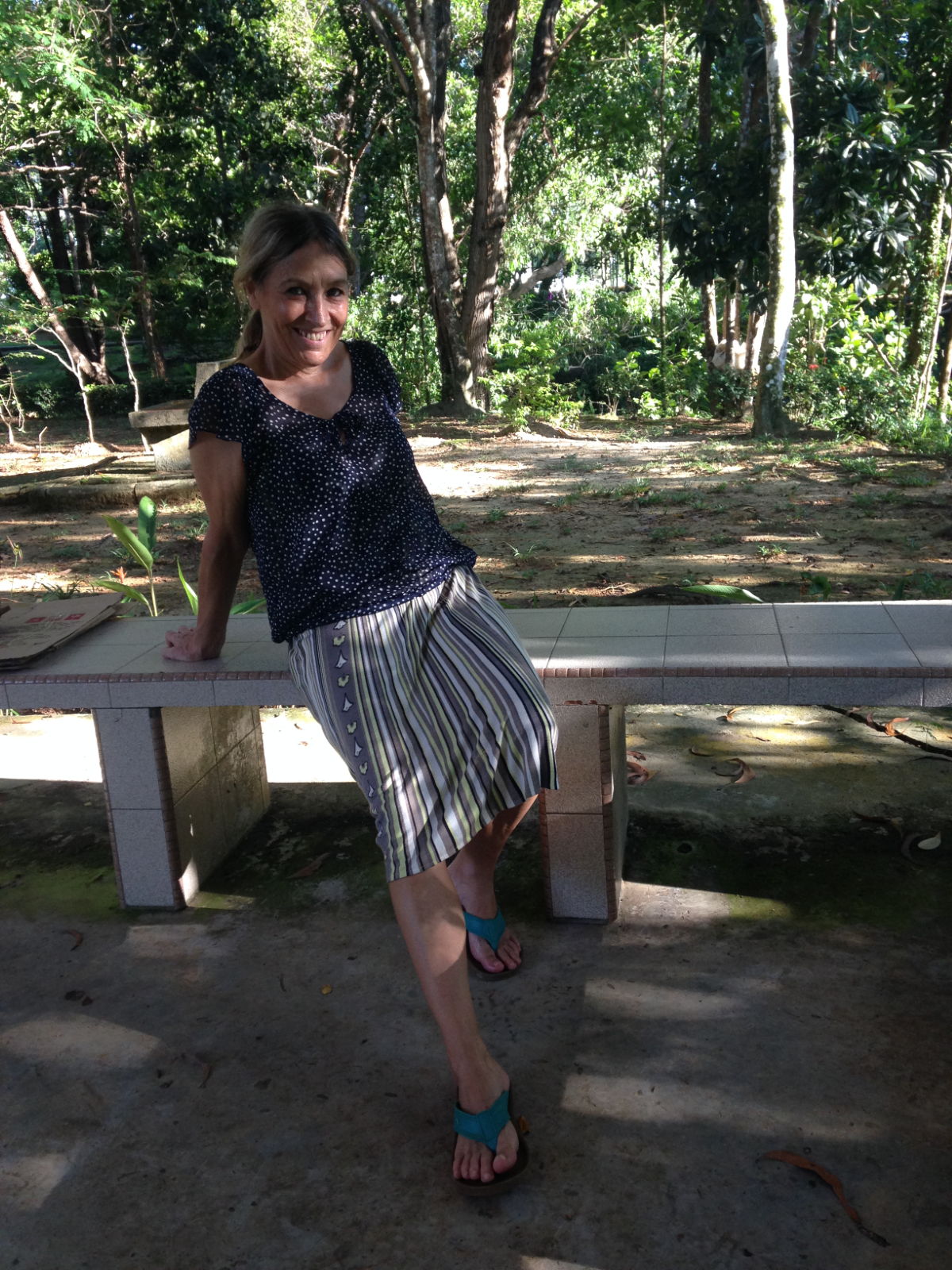
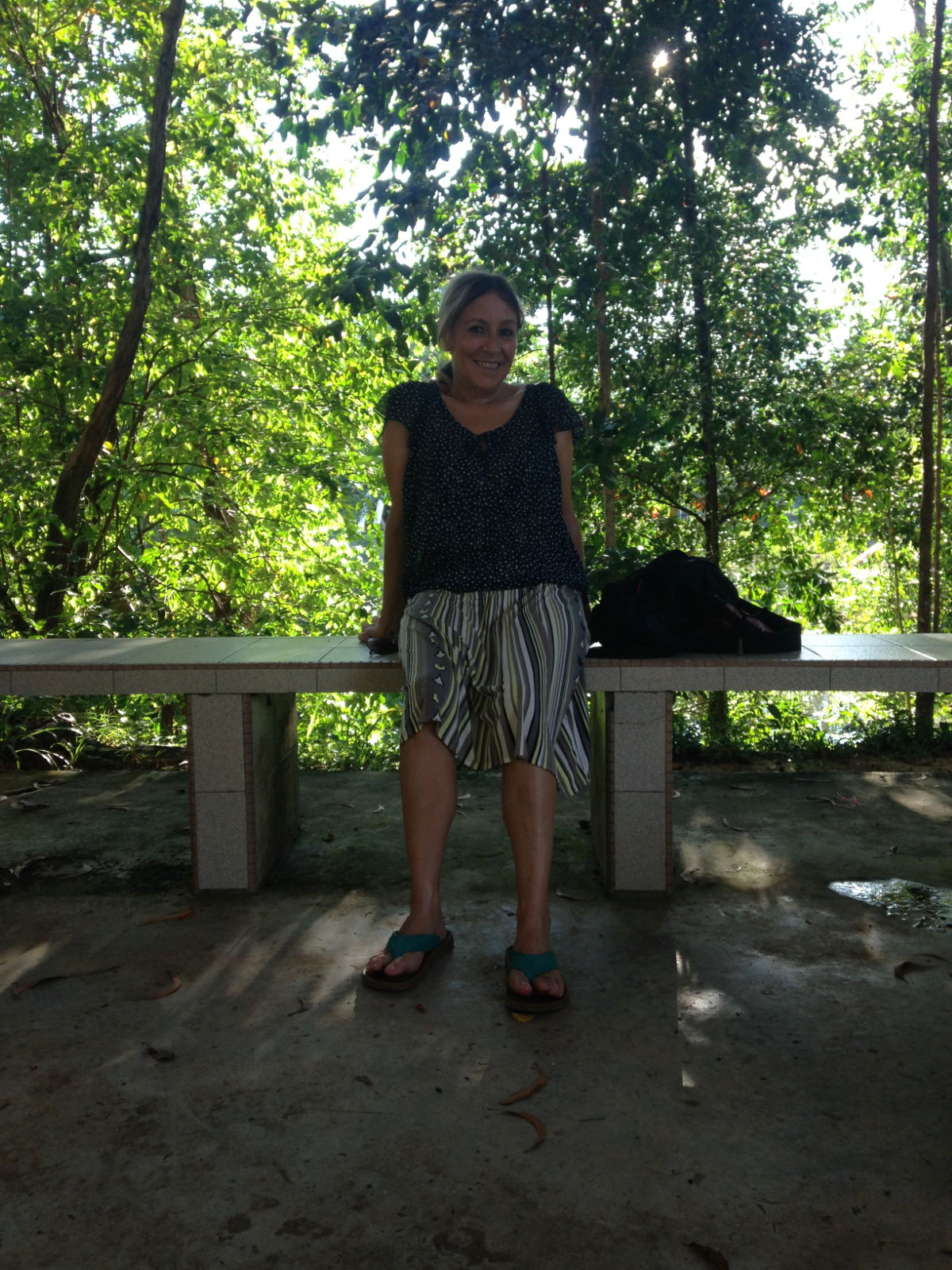



Our next cycle ride took us into the town centre early one evening to an Indian ‘café’ we’d looked up online. There had been a heavy, sultry heat all day and I had stayed in the cabin reading and feeling lethargic so I welcomed the prospect of a bike ride. We arrived at the restaurant sweating and thirsty and enjoyed an Indian feast accompanied by icy cold fresh fruit juices in an air conditioned (rather brightly lit) restaurant. As we began to cycle back, the rain started. It got heavier and heavier but we decided to just ride through it and it turned out to be a great experience. That was another enjoyable first for me – cycling in a torrential downpour, splashing through deep puddles while people laughed and waved at us.
For the next few days we continued to add to the wine collection, and also stocked up on cans of soda water and soft drinks. It began to rain more frequently and we got used to jumping up at the first sound of it to close all the hatches and windows. One afternoon, we could hear it pounding on the roof during a visit to the local museum. It had been an interesting hour in there reading about Labuan’s experiences in World War 2 under Japanese occupation. We emerged at about 5pm to witness a spectacular downpour. It was hard to see very far ahead and the sound it made was amazing. This was the NE monsoon making its presence felt. We stood for about 30 minutes watching it, along with a young couple and their little girl as we took shelter under the museum’s covered forecourt. We were amused when as soon as it began to lessen in force, the man walked over to their car, (using the protection of an umbrella) which was parked about 10 steps away from the shelter! Is there something they’re not telling us about the rain here! Anyway, we left at the same time to have another wet ride back to the boat. There was loud thunder all evening and the rain continued throughout the night.
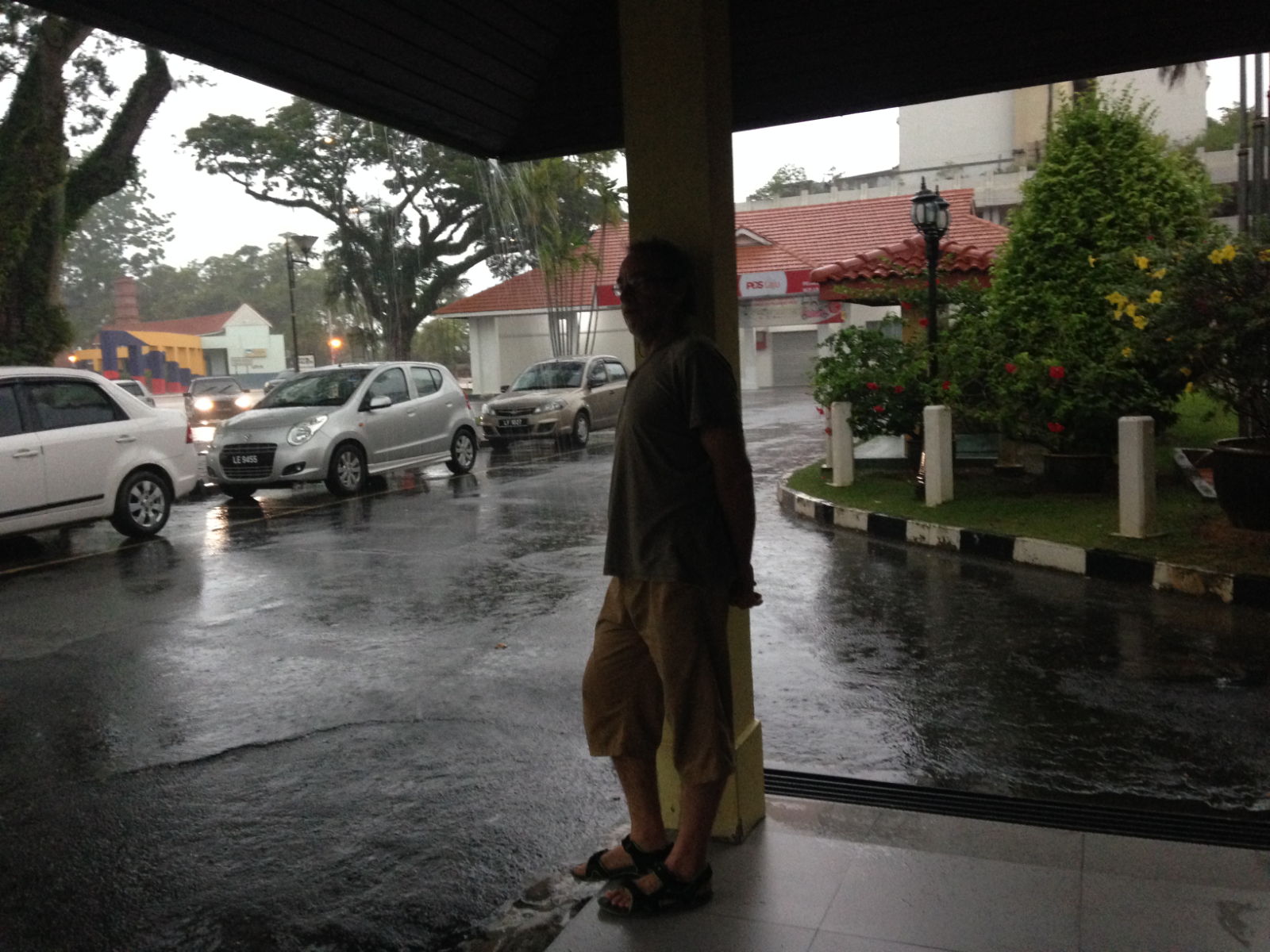
The museum visit had reignited my interest in the Second World War period in this area. There had been photographs and information of The Peace Park, the ‘Surrender Point’ plaque where the Japanese had signed the surrender in 1945, and the field where the war graves are located. When Paul suggested a trip to see these I was all for it. Our original plan had been to hire a car and visit a nearby spa but the rainy weather had put paid to that and I liked the thought of this excursion a lot better anyway. More steep hills to negotiate but it was a cool day with not much traffic around. The war cemetery was very moving. It’s extremely well kept by The Commonwealth Graves Commission. We spent a long time looking at the messages on the graves’ metal plaques – each one with a different and personal tribute.
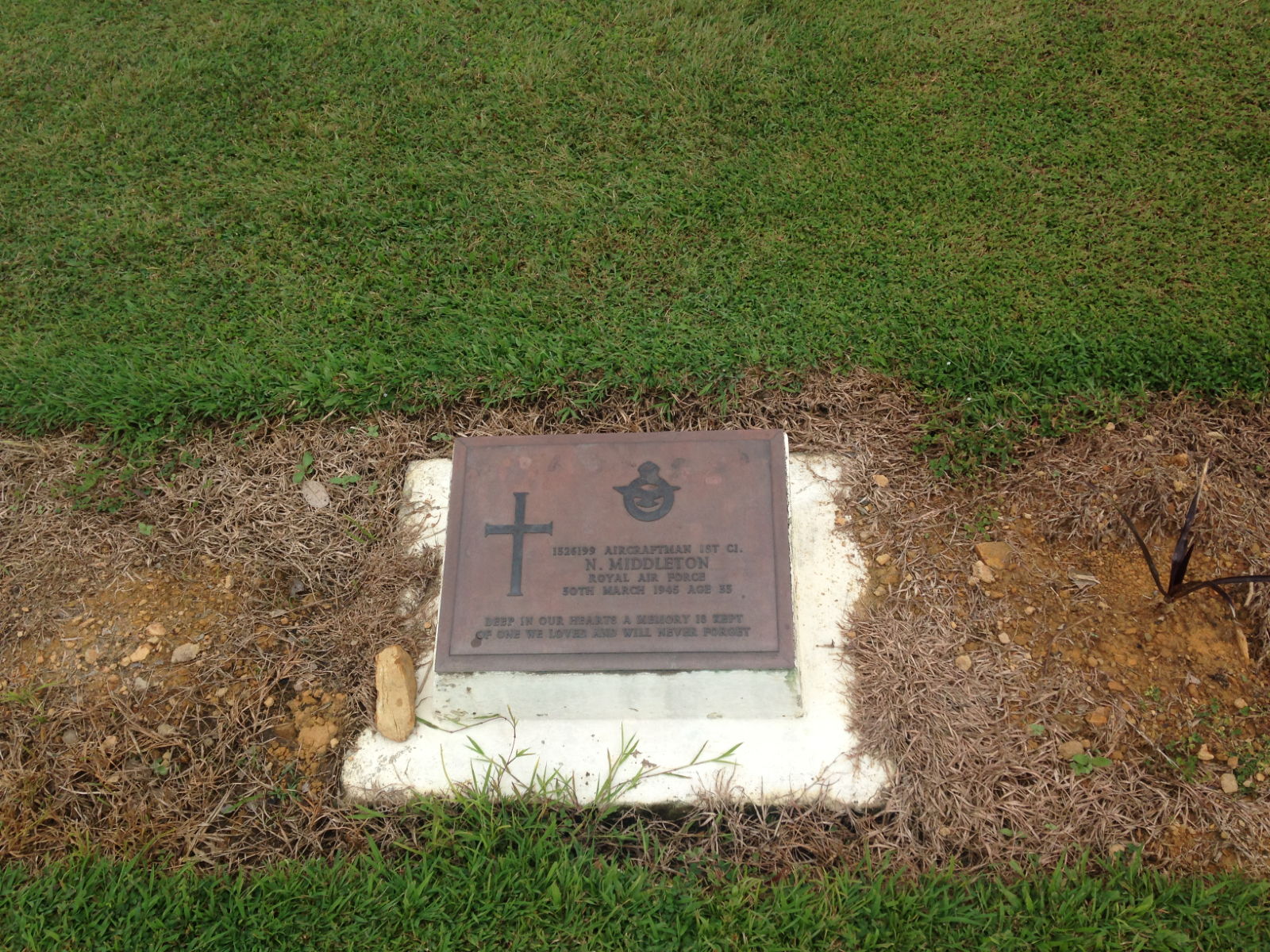
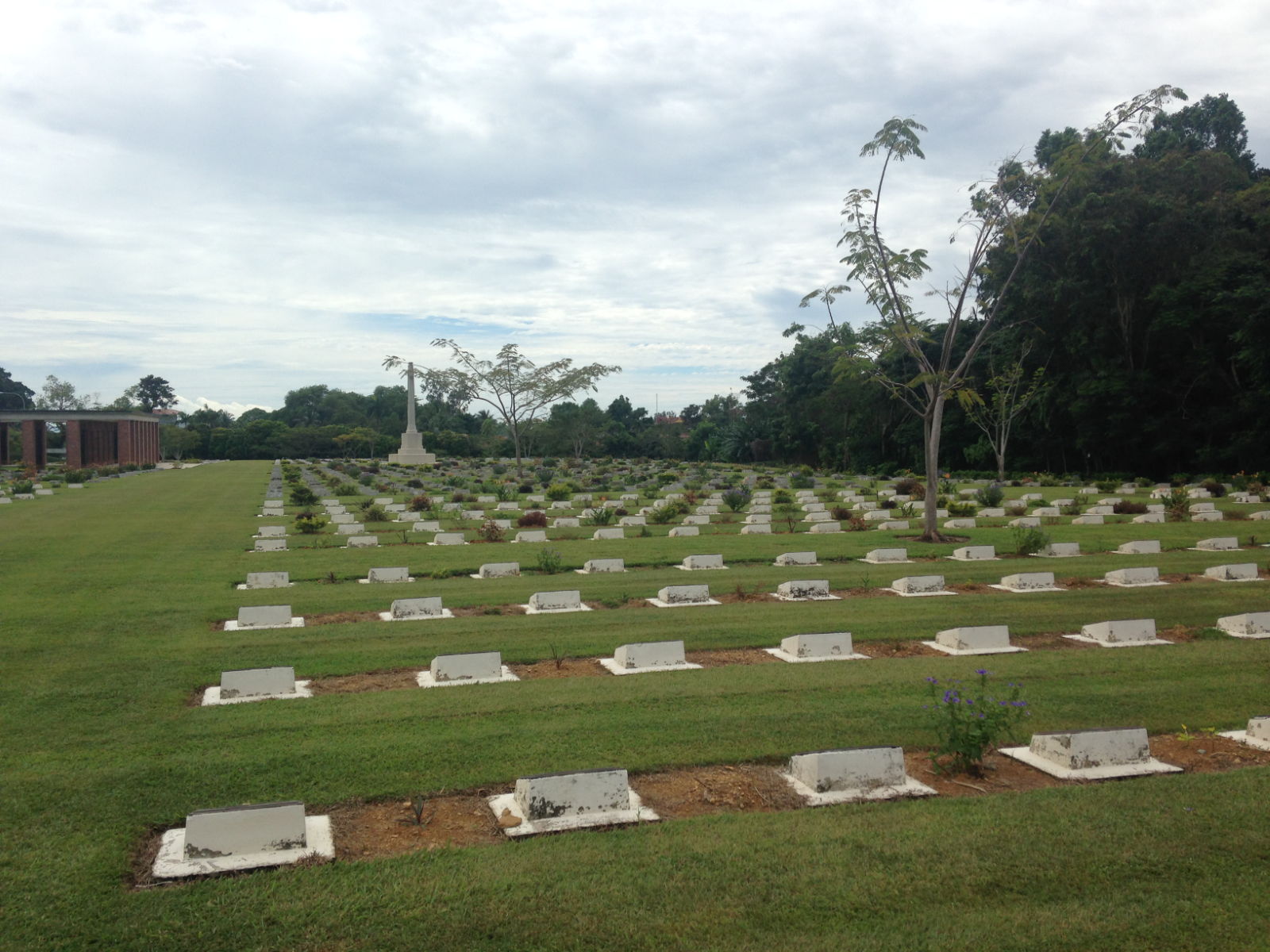
From there we went to a hypermarket in our ongoing search for ground coffee and non-dairy spread (so Guardian are we). Paul had a map that informed him where he could get ‘good cheese’ of all things but it didn’t mention coffee and didn’t live up to its promise regarding the cheese. The cheese here is imported obviously and therefore expensive but there was nothing different about it, and we couldn’t find any spread or coffee either. Cycling back in the heat, I thought of the reports of snow, frost, ice and cold winds we’ve been hearing about in Britain and found it hard to imagine after so long away. I still miss the contrast in seasons but at least I’m getting more of a sense of the monsoon season this year because we weren’t in Asia last December.

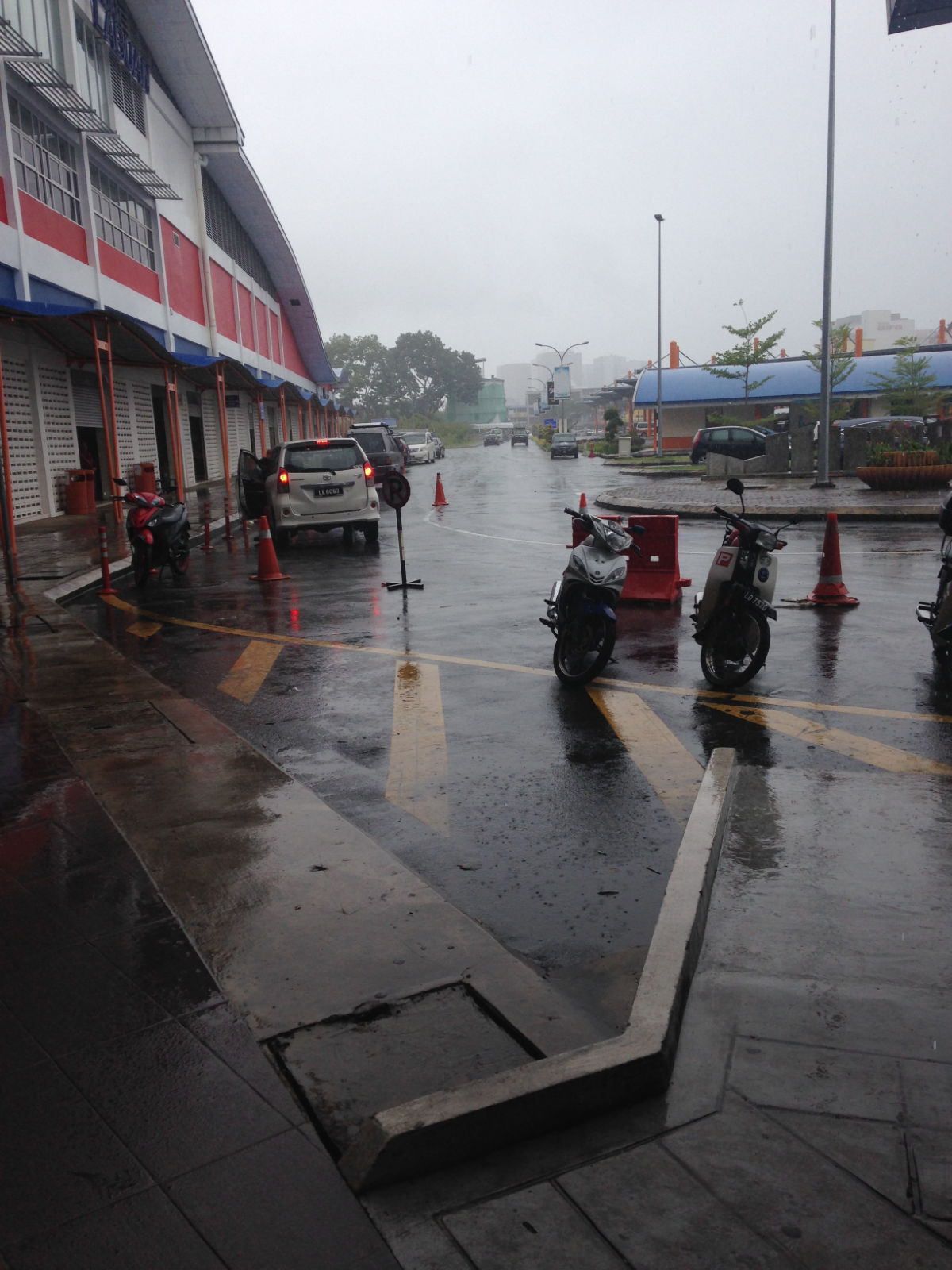
On Monday December 11th we set off early to go through the checking out process in readiness for the next day’s departure. The rain held off for a little while but it was soon pouring down heavily – too heavy to risk a drenching cycle back. We took shelter in the bakery/coffee shop where we buy our bread and I had my first cup of Malaysian ‘kopi’. I requested black, no sugar but the concept of anything without sugar amazes people here. I got it sugarless but the lady brought it over and pointed to the bowl of sugar on the table if I changed my mind. It looked like coffee and it was hot but the resemblance ended there. I don’t think I’ll order another one. We sat there and played ‘words with friends’ and waited and waited but the rain fell relentlessly. It was lunchtime by then and the aromas coming from the food made us hungry. It seems to be a popular place with office workers who were loading their plates with noodles and rice and fried eggs and tofu and veg and chicken from the hot buffet. We caved in, got ourselves a plate and chose a selection of the dishes which you could heap on a plate for as little as £1.50, and it was gorgeous. One more trip to buy wine and chocolate from the duty free mall and we were ready to leave Labuan in the morning. Our next destination would be Muara and then a much-anticipated trip up the Klias River to see the rare Proboscis monkeys.
Kathy
